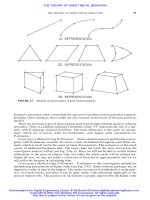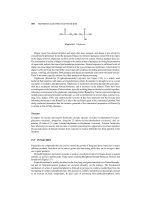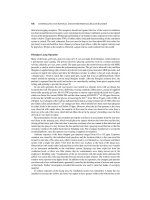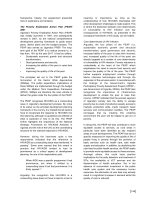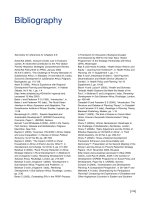Radio network planning and optimisation for umts 2nd edition phần 1 pptx
Bạn đang xem bản rút gọn của tài liệu. Xem và tải ngay bản đầy đủ của tài liệu tại đây (13.63 MB, 67 trang )
Radio Network Planning
and Optimisation
for UMTS
Second Edition
Edited by
Jaana Laiho and Achim Wacker
Both of Nokia Networks, Nokia Group, Finland
Toma
´
s
ˇ
Novosad
Nokia Networks, Nokia Group, USA
Radio Network Planning and
Optimisation for UMTS
Radio Network Planning
and Optimisation
for UMTS
Second Edition
Edited by
Jaana Laiho and Achim Wacker
Both of Nokia Networks, Nokia Group, Finland
Toma
´
s
ˇ
Novosad
Nokia Networks, Nokia Group, USA
Copyright # 2006 John Wiley & Sons Ltd, The Atrium, Southern Gate, Chichester,
West Sussex PO19 8SQ, England
Telephone (þ44) 1243 779777
Email (for orders and customer service enquiries):
Visit our Home Page on www.wiley.com
All Rights Reserved. No part of this publication may be reproduced, stored in a retrieval
system or transmitted in any form or by any means, electronic, mechanical, photocopying,
recording, scanning or otherwise, except under the terms of the Copyright, Designs and
Patents Act 1988 or under the terms of a licence issued by the Copyright Licensing Agency
Ltd, 90 Tottenham Court Road, London W1T 4LP, UK, without the permission in writing of
the Publisher. Requests to the Publisher should be addressed to the Permissions Department,
John Wiley & Sons Ltd, The Atrium, Southern Gate, Chichester, West Sussex PO19 8SQ,
England, or emailed to , or faxed to (þ44) 1243 770620
Designations used by companies to distinguish their products are often claimed as trademarks.
All brand names and product names used in this book are trade names, trademarks or registered
trademarks of their respective owners. The Publisher is not associated with any product or vendor
mentioned in this book.
This publication is designed to provide accurate and authoritative information in regard to
the subject matter covered. It is sold on the understanding that the Publisher is not engaged
in rendering professional services. If professional advice or other expert assistance is
required, the services of a competent professional should be sought.
Other Wiley Editorial Offices
John Wiley & Sons, Inc., 111 River Street, Hoboken, NJ 07030, USA
Jossey-Bass, 989 Market Street, San Francisco, CA 94103-1741, USA
Wiley-VCH Verlag GmbH, Boschstr. 12, D-69469 Weinheim, Germany
John Wiley & Sons Australia Ltd, 42 McDougall Street, Milton, Queensland 4064, Australia
John Wiley & Sons (Asia) Pte Ltd, 2 Clementi Loop #02-01, Jin Xing Distripark, Singapore 129809
John Wiley & Sons Canada Ltd, 22 Worcester Road, Etobicoke, Ontario, Canada M9W 1L1
Wiley also publishes its books in a variety of electronic formats. Some content that appears
in print may not be available in electronic books.
Library of Congress Cataloging-in-Publication Data
Radio network planning and optimisation for UMTS / edited by
Jaana Laiho, Achim Wacker, Toma
´
s
˘
Novosad
p. cm.
ISBN-13: 978-0-470-01575-9 (alk. paper)
ISBN-10: 0-470-01575-6 (alk. paper)
1. Global system for mobile communications. 2. Radio – Transmitters
and transmission. 3. Code division multiple access. I. Laiho, Jaana.
II. Wacker, Achim. III. Novosad, Toma
´
s
˘
. IV. Title: Radio network
planning and optimization for UMTS.
TK5103.483.R34 2005
621.384 – dc22 2005018248
British Library Cataloguing in Publication Data
A catalogue record for this book is available from the British Library
ISBN-13 978-0-470-01575-9 (HB)
ISBN-10 0-470-01575-6 (HB)
Project management by Originator, Gt Yarmouth, Norfolk (typeset in 10/12pt Times).
Printed and bound in Great Britain by Antony Rowe Ltd, Chippenham, Wiltshire.
This book is printed on acid-free paper responsibly manufactured from sustainable forestry
in which at least two trees are planted for each one used for paper production.
Contents
Preface xiii
Acknowledgements xvii
Abbreviations xix
1 Introduction 1
Jaana Laiho, Achim Wacker, Toma
´
s˘ Novosad, Peter Muszynski, Petri Jolma
and Roman Pichna
1.1 A Brief Look at Cellular History 1
1.2 Evolution of Radio Network Planning 2
1.3 Introduction to Radio Network Planning and Optimisation for UMTS 5
1.4 Future Trends 9
1.4.1 Towards a Service-driven Network Management 10
1.4.2 Wireless Local Area Networks (WLANs) 11
1.4.3 Next-generation Mobile Communication 15
References 16
2 Introduction to WCDMA for UMTS 19
Toma
´
s
ˇ
Novosad, David Soldani, Kari Sipila
¨
, Tero Kola and Achim Wacker
2.1 Mathematical Background of Spread Spectrum CDMA Systems 19
2.1.1 Multiple Access 19
2.1.2 Spread Spectrum Modulation 20
2.1.3 Tolerance of Narrowband Interference 21
2.2 Direct Sequence Spread Spectrum System 22
2.2.1 Modulation Example 23
2.2.2 Tolerance of Wideband Interference 24
2.2.3 Operation in Multi-path Environment 26
2.3 CDMA in Cellular Radio Networks 27
2.3.1 Universal Frequency Reuse 27
2.3.2 Soft Handover 27
2.3.3 Power Control 28
2.4 WCDMA Logical, Transport and Physical Channels 28
2.4.1 High-level UMTS Architecture Model 28
2.4.2 Radio Interface Protocol Architecture and Logical Channels 30
2.4.3 Transport Channels 37
2.4.4 Physical Channels and Mapping of Transport Channels
(FDD) 45
2.4.5 High-speed Downlink Packet Access (HSDPA) 60
2.4.6 Timing and Synchronisation in UTRAN (FDD) 65
2.4.7 Spreading, Scrambling and Channelisation Concepts 69
2.5 WCDMA Radio Link Performance Indicators 75
2.5.1 Definitions 76
2.5.2 Classification according to Multi-path Channel Conditions
and Services 80
2.5.3 Link-level Simulation Principles 83
2.5.4 Physical-layer Measurements Suppor ting the Measurement
of Link-level Performance in a Live Network 89
References 91
3 WCDMA Radio Network Planning 93
Achim Wacker, Jaana Laiho, Toma
´
s
ˇ
Novosad, Terhi Rautiainen and
Kimmo Tera
¨
va
¨
3.1 Dimensioning 95
3.1.1 WCDMA-specific Issues in Radio Link Budgets 95
3.1.2 Receiver Sensitivity Estimation 98
3.1.3 Shadowing Margin and Soft Handover Gain Estimation 99
3.1.4 Cell Range and Cell Coverage Area Estimation 100
3.1.5 Capacity and Coverage Analysis in the Initial Planning Phase 100
3.1.6 Dimensioning of WCDMA Networks with HSDPA 102
3.1.7 RNC Dimensioning 105
3.2 Detailed Planning 109
3.2.1 General Requirements for a Radio Network Planning Tool 110
3.2.2 Initialisation: Defining the Radio Network Layout 124
3.2.3 Detailed Uplink and Downlink Iterations 129
3.2.4 Adjacent Channel Interference Calculations 137
3.2.5 Post-processing: Network Coverage Predict ion and Common
Channel Analysis 139
3.3 Verification of Dimensioning with Static Simulations 142
3.3.1 Macro-cellular Network Layout 143
3.3.2 Introduction to the Simulation Parameters 144
3.4 Verification of Static Simulator with Dynamic Simulations 149
3.4.1 Introduction to the Dynamic Simulator 149
3.4.2 Comparison of the Results 151
3.5 Optimisation of the Radio Network Plan 154
3.5.1 Ideal Case 154
3.5.2 Shinjuku Case 158
vi Contents
3.6 Interference in WCDMA Multi-operator Environment 162
3.6.1 Sources of Adjacent Channel Interference 163
3.6.2 Minimum Coupling Loss 164
3.6.3 Dead Zones 166
3.6.4 ACI Simulation Cases 166
3.6.5 Guidelines for Radio Network Planning to Avoid ACI 174
3.7 Cell Deployment Strategies 175
3.7.1 Rollout 176
3.7.2 Hierarchical Cell Structures in WCDMA Networks 177
References 194
4 Radio Resource Utilisation 197
Achim Wacker, Jaana Laiho, Toma
´
s
ˇ
Novosad, David Soldani, Chris Johnson,
Tero Kola and Ted Buot
4.1 Introduction to Radio Resource Management 197
4.2 Power Control 198
4.2.1 Open-loop Power Control 198
4.2.2 Power Control on Downlink Common Channels 200
4.2.3 Inner-loop Power Control 201
4.2.4 Outer-loop Power Control 207
4.2.5 Power Control during Compressed Mode 209
4.2.6 Power Control with Transmit Power Control Command
Errors 210
4.2.7 Fast Power Control and User Equipment Speed 210
4.3 Handover Control 211
4.3.1 Intra-system–Intra-frequency Soft Handover 212
4.3.2 Intra-system–Intra-frequency Hard Handover 213
4.3.3 Intra-system–Inter-frequency Handover 213
4.3.4 Inter-system Handover 214
4.3.5 Handover Measurement Reporting 214
4.3.6 Compressed Mode 223
4.3.7 Inter-system Handover Procedure 224
4.4 Congestion Control 233
4.4.1 Definition of Air Interface Load 233
4.4.2 Admission Control 235
4.4.3 Packet Scheduling 237
4.4.4 Load Control 242
4.5 Resource Management 244
4.5.1 The Tree of Orthogonal Channelisation Codes in Downlink 244
4.5.2 Code Management 245
4.6 RRU for High-speed Downlink Packet Access (HSDPA) 250
4.6.1 Power Control for High-speed Downlink Packet Access 250
4.6.2 Congestion Control for High-speed Downlink Packet Access 252
4.6.3 Handover Control and Mobility Management for
High-speed Downlink Packet Access 253
4.6.4 Resource Manager for High-speed Downlink Packet Access 255
Contents vii
4.7 Impact of Radio Resource Utilisation on Network Performance 256
4.7.1 Impact of Fast Power Control and Soft Handover on
Network Performance 256
4.7.2 Radio Resource Management Optimisation Examples 267
4.7.3 Call Setup Delay 275
References 277
5 WCDMA–GSM Co-planning Issues 279
Kari Heiska, Toma
´
s˘ Novosad, Pauli Aikio, Chris Johnson and Josef Fuhl
5.1 Radio Frequency Issues 279
5.1.1 Thermal Noise 279
5.1.2 Man-made Noise 281
5.1.3 Interference Scenarios 281
5.1.4 Interference Reduction Methods 282
5.2 Noise Measurements 285
5.2.1 Acceptable Radio Frequency Environment 285
5.2.2 Conducting Measurements in a Real Environment 287
5.2.3 Measurement Results 289
5.2.4 Conclusions 292
5.3 Radio Network Planning Issues 293
5.3.1 Co-planning Process 294
5.3.2 Transmission Planning 301
5.3.3 Perception of Different Technologies by the End-user 302
5.3.4 Tight Usage of Frequency Spectrum by Different
Technologies 302
5.4 Narrowband and WCDMA System Operation in Adjacent
Frequency Bands 303
5.4.1 Interference Mechanisms 305
5.4.2 Worst Case Analysis 308
5.4.3 Simulation Case Study with a Static Simulator 310
5.4.4 Capacity Reduction 323
5.4.5 Summary and Radio Network Planning Guidelines 327
References 329
6 Coverage and Capacity Enhancement Methods 331
Chris Johnson, Achim Wacker, Juha Ylitalo and Jyri Ha
¨
ma
¨
la
¨
inen
6.1 Introduction 331
6.2 Techniques for Improving Coverage 332
6.2.1 Uplink and Downlink Coverage Limited Scenarios 332
6.2.2 Link Budget Analysis 333
6.3 Techniques for Improving Capacity 335
6.3.1 Uplink and Downlink Capacity Limited Scenarios 335
6.3.2 Load Equation Analysis 336
6.3.3 Identifying the Limiting Link 337
viii Contents
6.4 Uplink Cell Load and Base Station Transmit Power 338
6.4.1 Impact of Uplink Cell Load 339
6.4.2 Impact of Base Station Transmit Power 339
6.5 Additional Carriers and Scrambling Codes 342
6.5.1 Impact of Additional Carriers 342
6.5.2 Impact of Additional Scrambling Codes 344
6.6 Mast Head Amplifiers and Active Antennas 346
6.6.1 Mathematical Background 346
6.6.2 Impact of Mast Head Amplifiers and Active Antennas 347
6.6.3 Practical Considerations 349
6.7 Remote RF Head Amplifiers 349
6.7.1 Mathematical Background 351
6.7.2 Impact of Remote RF Head Amplifiers 351
6.7.3 Practical Considerations 352
6.8 Higher Order Receive Diversity 352
6.8.1 Impact of Higher Order Receive Diversity 353
6.8.2 Practical Considerations 354
6.9 Transmit Diversity 355
6.9.1 Impact of Transmit Diversity 357
6.9.2 Practical Considerations 359
6.10 Multiple Input Multiple Output in UTRA FDD 360
6.10.1 Mathematical Background 360
6.10.2 Impact of MIMO 362
6.10.3 Practical Considerations 362
6.10.4 Candidate MIMO Algorithms in 3GPP Standardisation 364
6.10.5 MIMO in UTRA FDD Uplink 367
6.11 Beamforming 367
6.11.1 Mathematical Background 368
6.11.2 Impact of Beamforming 369
6.11.3 Practical Considerations 370
6.11.4 Impact of Fixed Beam Approach upon Radio Resource
Management Algorithms 372
6.12 Rollout Optimised Configuration 373
6.12.1 Impact of Rollout Optimised Configuration 374
6.12.2 Practical Considerations 376
6.13 Sectorisation 376
6.13.1 Impact of Sectorisation 377
6.13.2 Practical Considerations 379
6.14 Repeaters 380
6.14.1 Impact of Repeaters 382
6.14.2 Practical Considerations 383
6.15 Micro-cell Deployment 383
6.15.1 Impact of Micro-cells 384
6.16 Capacity Upgrade Process 387
6.17 Summary of Coverage and Capacity Enhancement Methods 389
References 392
Contents ix
7 Radio Network Optimisation Process 395
Jaana Laiho, Markus Djupsund, Anneli Korteniemi, Jochen Grandell and
Mikko Toivonen
7.1 Introduction to Radio Network Optimisation Requirements 395
7.1.1 The Operations System’s Role in the Optimisation Process 398
7.2 Introduction to the Telecom Management Network Model 410
7.3 Tools in Optimisation 414
7.3.1 Planning Tool Level Optimisation 415
7.3.2 Configuration Management in a Network Management
System 419
7.3.3 Performance Management in Network Elements and in the
Operations System 422
7.3.4 Measurement Applications in Network Elements and in the
Network Management System 437
7.3.5 Optimisation Using Operations System Tools 446
7.3.6 Field Measurement Tool 447
7.4 Summary 452
References 454
8 UMTS Quality of Service 455
Jaana Laiho, Vilho Ra
¨
isa
¨
nen and Nilmini Lokuge
8.1 Definition of Quality of Service 455
8.2 End-user Service Classification 456
8.3 Characteristics and Requirements of Services 457
8.3.1 Generic Issues 458
8.3.2 Data Transfer 458
8.3.3 Interactive Data Transfer 459
8.3.4 Messaging 460
8.3.5 Streaming 460
8.3.6 Conferencing Media 461
8.4 3GPP Bearer Concept 461
8.4.1 Architectural Entities 462
8.4.2 Bearer Layers 463
8.4.3 Packet Data Protocol Context Characterisation 463
8.4.4 Comments about 3GPP Bearers 464
8.5 Overview of 3GPP Quality of Service Architecture 465
8.5.1 3GPP Quality of Service Architecture 465
8.5.2 Support for the IP Multimedia Sub-system 467
8.5.3 External Bearer Service 469
8.6 Quality of Service Management in UMTS 469
8.6.1 Introduction to Quality of Service Management
Challenges 470
8.6.2 Radio Bearer Mapping of UMTS Traffic Classes 473
8.6.3 Utilisation of Quality of Service in the UMTS Domain 474
8.7 Concluding Remarks 501
References 502
x Contents
9 Advanced Analysis Methods and Radio Access Network Autotuning 505
Jaana Laiho, Pekko Vehvila
¨
inen, Albert Ho
¨
glund, Mikko Kylva
¨
ja
¨
,
Kimmo Valkealahti and Ted Buot
9.1 Introduction 505
9.2 Advanced Analysis Methods for Cellular Networks 506
9.2.1 Introduction to Data Mining 506
9.2.2 Knowledge Discovery in Databases and Data Mining 507
9.2.3 Classification Trees 511
9.2.4 Anomaly (Outlier) Detection with Classificati on Tree 513
9.2.5 Self-Organising Map 513
9.2.6 Performance Monitoring Using the Self-Organising Map:
GSM Network 515
9.2.7 Performance Monitoring Using the Self-Organising Map:
UMTS Network 517
9.2.8 High Level Performance Analysis by Clustering Network
Performance Data: Case Study 528
9.3 Automatic Optimisation 536
9.3.1 Examples of Automated Optimisation 539
9.3.2 Network Scenario and Data Used in Algorithms with
Cost Function 539
9.3.3 Measurements and Costs Used in Algorithms 540
9.3.4 Autotuning in the Mobility Management Sub-system 543
9.3.5 Autotuning in the Call Admission Control Sub-system 552
9.3.6 Capacity Optimisation and Traffic Balancing 561
9.4 Summary 569
References 569
10 Other 3G Radio Access Technologies 573
Jussi Reunanen, Simon Browne, Pauliina Era
¨
tuuli, Ann-Louise Johansson,
Martin Kristensson, Jaana Laiho, Mats Larsson, Toma
´
s
ˇ
Novosad and
Jussi Sipola
10.1 GSM Packet Data Services 573
10.1.1 Introduction 574
10.1.2 Modulation and Coding Schemes 574
10.1.3 EDGE Radio Link Performance 577
10.1.4 GPRS Radio Link Performance 582
10.1.5 Coverage 583
10.1.6 Capacity Planning 586
10.1.7 Mobility Management 594
10.1.8 Frequency Hopping Techniques 598
10.1.9 Conclusion 600
10.1.10 EDGE Performance Assessment 600
10.1.11 Quality of Service and Service Optimisation for EGPRS 603
Contents xi
10.2 Time Division Duplex Mode of WCDMA (UTRA TDD) 606
10.2.1 Some Time Division Duplex Specific Properties 606
10.2.2 System Scenarios 607
10.2.3 Synchronisation of Cells 610
10.2.4 Single-operator Time Division Duplex Networks 610
10.2.5 Synchronisation in Multi-operator Time Division
Duplex Networks 611
10.2.6 Erlang Capacity for Time Division Duplex Networks:
A Simple Way of Estimating Capacity per Cell 612
10.2.7 Co-existing Time Division Duplex and Frequency
Division Duplex Networks 612
10.2.8 Co-located and Close Proximity Local Area Base
Station System (BSS) 614
10.2.9 Radio Performance 614
10.2.10 Time Division Duplex and Frequency Division Duplex
Processing Gains 615
10.2.11 Time Division Duplex Link Budget Examples 615
10.2.12 Some Other Important Parameters and their Effect on the
Radio Link Budget 618
10.2.13 Summary 618
References 619
Index 621
xii Contents
Preface
Second-generation (2G) mobile communication systems have enabled voice traffic to go
wireless. More important, however, have been the accompanying standardisation,
compatibility and international transparency that were simply not available to tele-
communications equipment of the previous analogue generation. These features have
helped 2G systems to spread rapidly around the world, with very high cellular phone
penetration rates in many countries. Cellular networks have enabled certain types of
communication to take place on a massive scale that previously were not possible or
were at least severely limited. In the field of network building and expansion the main
advances have been in planning the radio and transmission part of the network and in
optimising the processes and activities necessary to run existing operational networks.
The third-generation (3G) system known as the Universal Mobile Telecommunica-
tions System (UMTS) intr oduces very variable data rates on the air interface, as well as
the independence of the radio access infrastructure and the service platform. For users
this makes available a wide spectrum of circuit-sw itched or packet data services through
the newly developed high bit rate radio technology named Wideband Code Division
Multiple Access (WCDMA). The variable bit rate and variety of traffic on the air
interface have presented completely new possibilities for both operators and users,
but also new challenges to network planning and optimisation.
This book gives detailed descriptions of the radio network planning and optimisation
of UMTS networks based on Frequency Division Duplex (FDD) WCDMA technology
up to Release 5 of the 3GPP standardisation work – i.e., one main enhancement of this
second edition is the inclusion of High-speed Downlink Packet Access (HSDPA). One
chapter is dedicated to the General Packet Radio System (GPRS) and Time Division
Duplex (TDD) access mode of WCDMA. The optimisation and Quality of Service
(QoS) aspects have, however, a wider scope, than in (W)CDMA radio technology only.
Chapter 1 intro duces the history of cellular telecommunication and the changes in
planning and operation of such networks. The challenges of network planning,
optimisation and operation the operators and the wireless industry are facing on the
way to 3G systems are introduced together with an outlook on future developments in
the area towards fourth-generation (4G) systems.
Chapter 2 is in three sections. The first introduces the general background of Spread
Spectrum Systems. This is followed by a section related to the Third Generation
Partnership Project (3GPP), giving a panoramic view of the UMTS architecture,
interfaces and functions that impact directly upon radio network planning. HSDPA
physical layer properties are added as a new content in 3GPP Release 5. The third
section discusses WCDMA-specific link performance indicators relevant for radio
network dimensioning and planning.
Chapter 3 treats WCDMA radio network planning as a wider process that includes
network dimensioning with a special section for HSDPA, detailed planning, re-
quirements for planning tools, algorithms used for calculations in WCDMA and
optimisation of the radio network plan. The relationship between network dimension-
ing, detailed network planning and dynamic network simulation is also discussed. The
chapter closes with a discussion on cell deployment strategies with respect to the
number of frequencies and the network structure. This topic is presented as a case
study.
Chapter 4 covers Radio Resource Management (RRM) from the point of view of
radio resource utilisation, including power control, handover control, congestion
control (admission control, load control and packet scheduling), resource
management and certain impacts of those functions upon network performance.
A separate new section is devoted to RRM for HSPDA.
In Chapter 5, first the background noise measurement along with measured results
are introduced. This part is followed by co-planning issues involving WCDMA and the
Global System for Mobile communication (GSM), eventually other technologies. The
third part of the chapter describes the effects of intersystem interference, together with
dynamic mobile station receiver properties on network performance. The application of
these methods and results is not, however, limited to the GSM–WCDMA scenario.
Chapter 6 treats various coverage and capacity enhancement techniques (beam-
forming, higher order receive diversity, transmit diversity, MIMO technology, mast
head amplifiers, repeaters, rollout optimised configuration, sectorisation, etc.). The
chapter is based on an extensive set of case studies and contains practical examples
and conclusions.
Chapter 7 introduces the concept of statistical optimisation and discusses 3GPP
Release 5 contributions in the management area including configuration and per-
formance management issues. Furthermore, the TeleManagement Forum enhanced
Telecom Operations Map (TMF eTOM) model is briefly introduced. A 3GPP
management model for the multi-vendor environment is addressed. The management
system’s role in optimisation is presented and examples of management level products
and their capabilities are provided.
Chapter 8 focuses on UMTS QoS mechanisms according to 3GPP Release 5 and
examples of practical realisations of the QoS capabilities in network elements are
introduced. Furthermore, QoS as a differentiation enabler for operators is demon-
strated and differentiation possibilities with the QoS concept are presented. The
optimisation loop expansion from the network layer to the service layer is described.
Chapter 9 is devoted to advanced analysis methods and automated optimisation.
Several new analysis methods for network performance analysis are introduced.
In the area of automated optimisation examples of optimisation logic are provided
for the mobility management area, ad mission decision optimisation and capacity
optimisation in UMTS networks.
Finally, Chapter 10 deals with two technologies that are different from the FDD
mode of WCDMA. The first is the GPRS branch in GSM technology. This has brought
variable rate packet data traffic into the air interface of originally circuit switched and
xiv Preface
single data rate service-oriented technology. The second, the Time Division Duplex
(TDD) mode of WCDMA, represents an interesting technology for high data rate
indoor users. Therefore, the radio performance properties of TDD mode are
introduced.
On the CD accompanying the first edition of this book we included a static radio
network simulator implemented in Matlab
1
together with detailed descriptions of the
algorithms used. Most of the simulated scenarios are added, but not all the values
presented can be reproduced exactly, since simulations have been done partly by
using earlier versions of the tool, which used slightly different strategies. The tool is
delivered in its current version and state, and the authors do not give any warranty
concerning the correctness of the code. In addition, some coloured figures – in PDF
format – are included. The simulator, its description and the figures can now be found
at www.wiley.com/go/laiho.
The book is targeted at wireless operators, network and terminal manufacturers,
university students, frequency regulation bodies and all those interested in radio
network planning and optimisation, especially network systems RF engineering
professionals. This book represents the views and opinions of the authors, which are
not necessarily those of their employers.
Preface xv
Acknowledgements
The editors would like to acknowledge the effort and time invested by colleagues, both
from Nokia and outside, who ha ve contributed to this book. Apart from the editors,
the contributors were Pauli Aikio, Simon Browne, Ted Buot, Markus Djupsund,
Pauliina Era
¨
tuuli, Josef Fuhl, Jochen Grandell, Kari Heiska, Jyri Ha
¨
ma
¨
la
¨
inen,
Albert Ho
¨
glund, Ann-Louise Johansson, Chris Johnson, Petri Jolma, Tero Kola,
Anneli Korteniemi, Martin Kristensson, Mikko Kylva
¨
ja
¨
, Mats Larsson, Nilmini
Lokuge, Peter Muszynski, Roman Pichna, Terhi Rautiainen, Jussi Reunanen, Vilho
Ra
¨
isa
¨
nen, Kari Sipila
¨
, Jussi Sipola, David Soldani, Kimmo Tera
¨
va
¨
, Mikko Toivonen,
Kimmo Valkealahti, Pekko Vehvila
¨
inen and Juha Ylitalo.
The editors would like to thank Tero Ojanpera
¨
and Peter Muszynski for initial review
of the first edition. During the development of the second edition man y of our
colleagues from various Nokia sites offered support and help in suggesting improve-
ments, finding errors or providing figures or editorial advice. The editors would like to
express their gratitude especially to Kati Ahvonen, Erkka Ala-Tauriala, Renaud Cuny,
Outi Hiironniemi, Zhi-Chun Honkasalo, Salla Huttunen, Christian Joergensen, Janne
Kera
¨
nen, Mika Kiikkila
¨
, Outi Keski-Oja, Pekka Kohonen, Thomas Lammert, Jani
Lakkakorpi, Joni Lehtinen, Klaus Rasmussen, Mikko Rinne, Juha Ra
¨
sa
¨
nen, Anna
Sillanpa
¨
a
¨
, Kristian Skinne, Antti Toskala and Werner Trapp.
The publishing team at John Wiley & Sons, Ltd led by Mark Hammond, has done an
outstanding job in the production of this book. We are especially grateful to Sarah
Hinton for her patience, guidance and assistance.
We would like to express special thanks to our employer, Nokia Networks, for
general permission, support and encouragement, and for providing some of the
illustrations.
We also wish to acknowledge the effort of our colleagues from the Optimizer and
Network System Research teams as well as from planning services, for their practical
work in 3G planning studies conducted in a number of cities and environments around
the world and for their valuable input from the field.
Last, but not least, we would like to say a big thank-you to our families and friends,
as well as those of all the authors and reviewers, for their patience and supp ort
throughout this project.
The editors and authors welcome any comments and suggestions for improvement or
changes that could be implemented in possible future editions.
Jaana Laiho, Achim Wacker and Toma
´
s
ˇ
Novosad
Espoo, Finland and Dallas, Texas
Abbreviations
16QAM 16 State Quadrature Amplitude Modulation
2G 2nd Generation
2.5G 2.5th Generation
3G 3rd Generation
3GPP 3rd Generation Partnership Project
3GPP2 3rd Generation Partnership Project 2
4G 4th Generation
8-PSK 8 Phase Shift Keying
AAL2 ATM Adaptation Layer type 2
Abis GSM Interface BTS–BSC
AC Admission Control
ACI Adjacent Channel Interference
ACIR Adjacent Channel Interference power Ratio
ACK ACKnowledgement
ACLR Adjacent Channel Leakage power Ratio
ACP Adjacent Channel Protection
ACS Adjacent Channel Selectivity
AGCH Access Grant CHannel
AI Acquisition Indicator
AICH Acquisition Indicator CHannel
ALCAP Access Link Control Application Part
AM Acknowledged Mode
AMC Adaptive Modulation and Coding
AMPS Advance Mobile Phone Service
AMR Adaptive Multi Rate
AP Access Point; Access Preamble
AP-AICH Access Preamble Acquisition Indicator CHannel
API Application Programming Interface
APN Access Point Name
APP APPlication specific functions
ARP Allocation Retention Priority
ARQ Automatic Repeat reQuest
AS Access Slot; Access Stratum
ASC Acces s Service Class
AST Active Session Throughput
ASU Active Set Update
ATM Asynchronous Transfer Mode
AVI Actual Value Interface
AWGN Additive White Gaussian Noise
AXC ATM Cross Connect
B(T)S Base (Transceiver) Station
BA BCC H Allocation
BB BaseBand
BCC Base station Colour Code
BCCH Broadcast Control CHannel
BCH Broadcast CHannel
BCS Binary Coded Signalling
BEP Bit Error Probability
BER Bit Error Rate
BFN Node B Frame Number
BLER BLock Error Rate
BM Business Management
BMC Broadcast/Multicast Control
BMU Best Matching Unit
BPSK Binary Phase Shift Keying
BSC Base Station Controller
BSIC Base Station Identity Code
BSS Base Station Subsystem
BSSMAP Base Station System Management Application Part
BTFD Blind Transport Format Detection
BYE Session termination
C/I Carrier-to-Interference ratio
C_ID Cell IDentification
C450 Analogue second-generation system in Germany
CAPEX CAPital EXpenditure
CART Classification And Regression Tree
CB Cell Broadcast
CBR Call Block Ratio
CC Cal l Control; Convolutional Coding; Cumulative Counter
CCCH Common Control CHannel
CCH Control CHannel
CCPCH Common Control Physical CHannel
CCTrCH Coded Composite Transport CHannel
CD Collision Detection
CD/CA-ICH Collision Detection/Channel Assignment Indicator CHannel
CD-DSMA Collision Detection-Digital Sense Multiple Access
CDF Cumulative Distribution/Density Function
CDMA Code Division Multiple Access
CFN Connection Frame Number
CGI Cell Global Identification
CI Cell Identity
xx Abbreviations
CIO Cell Individual Offset
CM Compressed Mode; Configuration Management
CMIP Common Management Information Protocol
CN Core Network
CNAME Canonical NAME
CORBA Common Object Request Broker Architecture
COST European COoperation in the field of Scientific and Technical
research
C-plane Control plane
CPCH Common Packet CHannel
CPICH Common PIlot CHannel
CQI Channel Quality Indicator
CRC Cyclic Redundancy Check
CRMS Common Resource Management Server
CRNC Controlling RNC
CRRR Capacity Request Rejection Ratio
CRS Cel l Resource Server
CS Coding Scheme; Circuit Switched
CSI Channel State Information
CSICH CPCH Status Indicator CHannel
CSSR Call Setup Success Ratio
CSW Circuit SWitched (GPRS terminology)
CTCH Common Traffic CHannel
CWND Congestion WiNDow
D-AMPS Digital AMPS
DCA Dynamic Channel Allocation
DCCH Dedicated Control CHannel
DCH Dedicated CHannel
DCN Data Communication Network
DCR Drop Call Ratio
DCS1800 Digital Cellular System (GSM) at 1800 MHz band
DER Discrete Event Registration
DGPS Differential GPS
DHCP Dynamic Host Client Protocol
DHO Diversity HandOver
DiffServ Differentiated Services
DL DownLink
DN Distinguished Name
DNS Domain Name Server
DoA Direction of Arrival
DOFF Default OFFset
DPCCH Dedicated Physical Cont rol CHannel
DPCH Dedicated Physical CHannel
DPDCH Dedicated Physical Data CHannel
DQPSK Differential QPSK
DRNC Drifting RNC
Abbreviations xxi
DRX Discontinuous Reception
DS Direct Sequence
DSCH Downlink Shared CHannel
DSCP DiffServ Code Point
DSL Digital Subscriber Line
DSMA-CD Digital Sense Multiple Access–Collision Detection
DSTTD-SGRC Double STTD with Sub-Group Rate Control
DTCH Dedicated Traffic CHannel
DTX Discontinuous Transmission
D-TxAA Double Transmit Antenna Array
DVB Digital Video Broadcasting
E1 Standard 2 Mbps transmission line
E3G Enhanced 3G
EDGE Enhanced Data rates for GSM Evolution
EFR Enhanced Full Rate
EGPRS Enhanced GPRS
EIA Electronic Industry Alliance
EIRP Equivalent Isotropic Radiated Power
EM Element Manager
ERC European Radiocommunications Committee
ES Enterprise Systems
eTOM Enhanced TOM
ETSI European Telecommunications Standards Institute
FACH Forward Access CHannel
FAUSCH FAst Uplink Signalling CHannel
FBI FeedBack Information
FCC Federal Communications Commission
FCS Frame Check Sequence
FDD Frequency Division Duplex
FDMA Frequency Division Multiple Access
FEC Forward Error Correction; Forwarding Equivalence Class
FER Frame Erasure Rate
FH Frequency Hopping
FIFO First In First Out
FM Fault Management
FN Frame Number
FP Frame Protocol
FTP File Transfer Protocol
FW Firmware
G Geometry factor
GAUGE (Dynamic variable), used when data being measured can vary up
or down during the period of measurement
GB Guaranteed Bit rate
Gbps Giga bits per seconds
GERAN GSM EDGE RAN
GGSN Gateway GPRS Support Node
xxii Abbreviations



